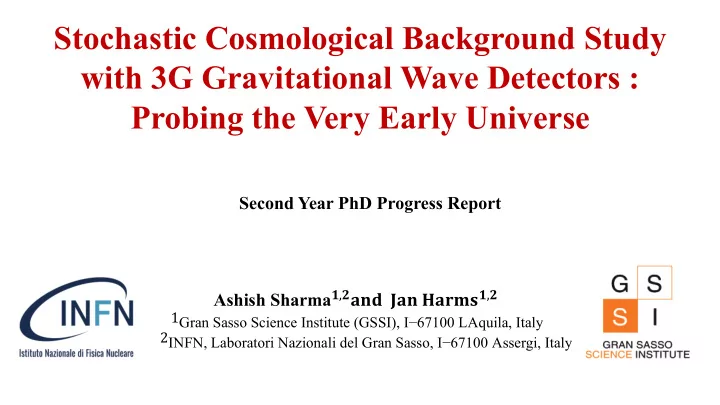

Stochastic Cosmological Background Study with 3G Gravitational Wave Detectors : Probing the Very Early Universe Second Year PhD Progress Report Ashish Sharma 𝟐,𝟑 𝐛𝐨𝐞 𝐊𝐛𝐨 𝐈𝐛𝐬𝐧𝐭 𝟐,𝟑 1 Gran Sasso Science Institute (GSSI), I−67100 LAquila, Italy 2 INFN, Laboratori Nazionali del Gran Sasso, I−67100 Assergi, Italy
Outline • Motivation • Stochastic background • Cosmological source of GWs • Best-fit subtraction • Projection method • Results • Conclusion 10/10/19 Ashish Sharma 2
Motivation • A GW stochastic background may be next class signal detected. • It would be a statistical detection, confidence level will grow with the observation time. • Produced very shortly after big bang. • Carry Information to study early universe phenomenon not accessible by EM ways. • signals will help us to understand the characteristics of the primordial signals, the fundamental physics and the evolution of the Universe. 10/10/19 Ashish Sharma 3
Stochastic Background • An incoherent superposition of large number of resolved and unresolved sources defined by statistical properties, isotropic, unpolarized, stationary and Gaussian. ? , 𝜍 = = > = ? @ A Ω /0 𝑔 = 3 64 78 4 5 6 9: ; BC/ • Uncorrelated gravitational wave sources can be of astrophysical or cosmological sources. • Cosmological: Signal of Early Universe • Inflationary epoch • Phase transitions • Cosmic Strings • Astrophysical • Supernovae • Magnetars • Binary Objects (BH, NS) 10/10/19 Ashish Sharma 4
Energy Spectra of SCGW Backgrounds LVC, Nature 460 , 990-994 (2009) 10/10/19 Ashish Sharma 5
BBH Background Spectrum LVC, PRL 119, 029901 (2017) 10/10/19 Ashish Sharma 6
Sensitivity Level for GW Detectors T. Regimbau et al, PRL 118 (2017) 15, 151105 10/10/19 Ashish Sharma 7
Luminosity Distance and Binary mass Distribution 10/10/19 Ashish Sharma 8
Subtraction- Noise Projection Method • This method is based on a geometrical interpretation of matched filtering and allows to access the weak signals like a stochastic GW background, irrespective of the residual noise in the data. • How we used this method • Injections: Generated a frequency domain strain containing the instrumental noise and signal for 1000 binary black-holes (BH). • Subtraction: Performing the parameter estimation to best-fit waveform, which will give us residual noise data after subtraction • Projections: Using residual noise data and Fisher matrix to perform the projection method to project out the residual noise data and search for stochastic background. 10/10/19 Ashish Sharma 9
Fisher Matrix : Signal Model and It’s derivatives Γ EF = 𝜖 E 𝑈 I 𝜖 F 𝑈 I 𝑒𝑔 𝑆𝑓(𝜖 E 𝑈 I 𝑔 𝜖 F 𝑈 I∗ 𝑔 ) L Γ EF = 2 J 𝑇 T (𝑔) K • 𝑈 I represent the signal model depending on 𝜇 E parameters used to analyse the data. • Fisher matrix defined the manifold of all physical waveform of binary objects. • Normalized Fisher matrix and Inverse Fisher matrix are computed to define the subtraction noise projection operator. 10/10/19 Ashish Sharma 10
Projection of Subtraction Errors 𝑄 = 1 − Γ EF 𝜖 E 𝐼 ⟨𝜖 F 𝐼 | Projection operator Projected data stream 𝑄𝑈 [\]^6_`a (𝑔) = 𝑈 [\]^6_`a (𝑔) − Γ EF 𝜖 F 𝑈 I 𝑈 [\]^6_`a 𝜖 E 𝑈 I (𝑔) 10/10/19 Ashish Sharma 11
Overlap Reduction Function And Optimal Filter • Quantify the instrumental influence on the correlation strength of detector outputs. γ xy f = 5 Ωe x€•‚• ƒ . ∆… J d• ~ (• ~ (• † F 3 8π } Ω)F € Ω) ~ Ω 1 ‰ • ‹Œ = e ‹Œ Š − 𝑍 • • ‰ ~ ` 𝑌 ^ ` 𝑍 Š 𝐺 Ω = 𝑓 `Š Ω d x 2 𝑌 ^ ^ ^ ^ • The choice of filter depends upon the statistical properties of stochastic background and location and orientation of detectors. ? 𝑅 ^• (𝑔) = ‘ ; ƒ 78 (;)@ A ; ’ “ ” (;)“ • (;) 12 10/10/19 Ashish Sharma
Detector Sensitivity After Subtraction-Noise Projection 10/10/19 Ashish Sharma 13
Conclusion • Subtraction noise projection method is effective in reducing the residual noise data. • Geometrical Interpretation of matched filtering and parameter estimation easy and realistic approach for such a method. • Increasing the possibility of detecting a cosmological background signal with third generation gravitational wave detectors. 10/10/19 Ashish Sharma 14
Plan for Following Year • Testing efficiency of projection method on low-SNR CBC signals. • Check compatibility of subtraction-noise projection methods with arbitrary waveforms and compare the dependence of the subtraction and projection on the model for search. • Injection of different types of primordial backgrounds into data and assess their detectability with 3G networks, sensitivity of 3G detectors network towards stochastic backgrounds with and without the projection. • Comparing the projection method with alternative approaches (computationally expensive full Bayesian analysis of a CBC foreground + primordial background). • Implementing the projection pipeline in existing LIGO/Virgo codes. 10/10/19 Ashish Sharma 15
10/10/19 Ashish Sharma 16
10/10/19 Ashish Sharma 17
10/10/19 Ashish Sharma 18
10/10/19 Ashish Sharma 19
10/10/19 Ashish Sharma 20
Recommend
More recommend